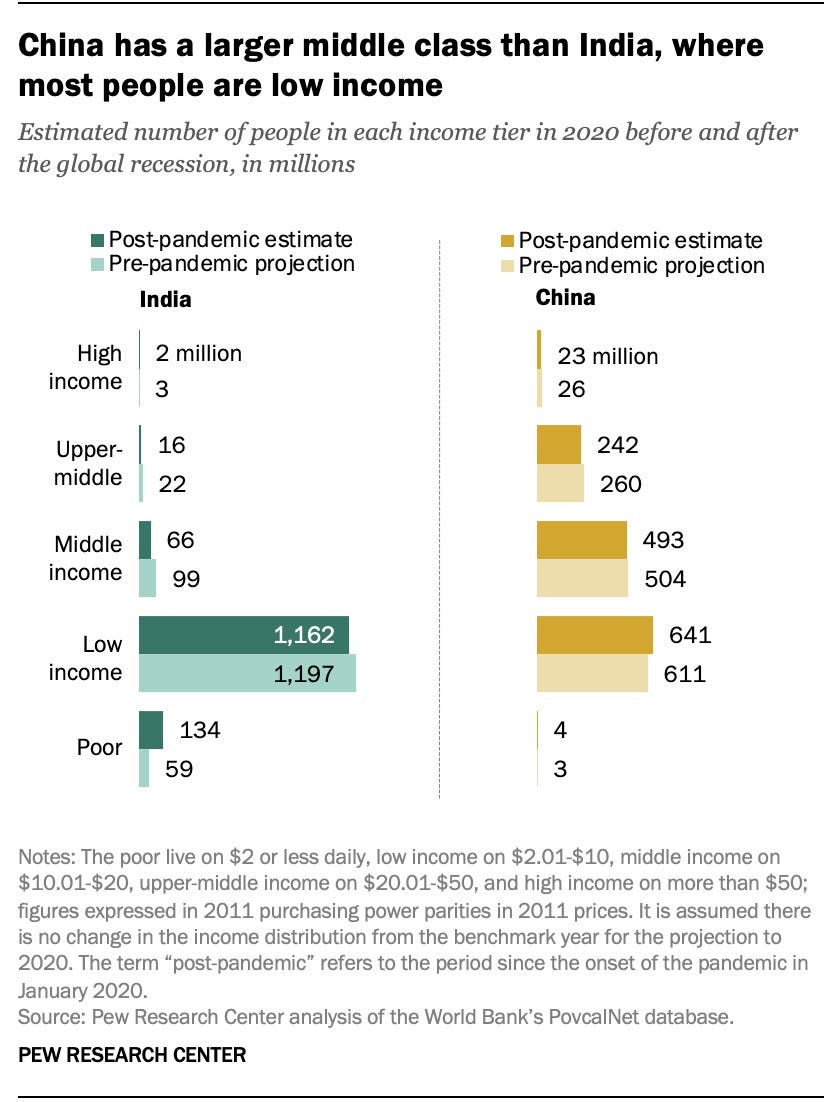The India Playbook: The missing middle class
India contains multitudes and demands a fit-to-context playbook. I explore ten insights into the Indian market over ten emails. Part III: The missing middle class.
Newsletter on ideas that help marketers do better and be better. Subscribe here.
Over the next few weeks, you will receive ten emails from me. Each mail will decode one insight about India and what it means for business.
Part III - The missing middle class.

In the previous edition, we saw that India is not one homogenous market. Instead, India is like a railway carriage. Within the same carriage is a microcosm of disparate marketplaces — CEOs sporting AirPods sit next to dhoti-clad farmers. Daily wage earners, equipped with basic feature phones and 1GB of daily data that they ration out to their entire family share the same space with auto-rickshaw drivers whose children study for IIT exams under the streetlights in front of Bombay Chawls.
If we eavesdrop, we will hear the CEO say that he is just a humble middle-class guy. In the global scheme of things, he would be right. But in India, he might be amongst the wealthiest top 1%.
That’s because India has no middle class - our rich earn what the average middle class in the rest of the world earns.
Think of the middle class as a rotund belly
If we think of an economy as a human body, the middle class is its belly. While a large button-popping belly in a human is a sign of ill health, in the case of a country, the larger the belly, the healthier the economy.
The middle class is important because it is a growth-compounding agent for any economy because it produces goods and services —> earns a stable living —> and then consumes more goods and services. Over time, this not only grows but also compounds GDP.
Generally, the middle class comprises a group of educated white-collar professionals, flanked by the lower (blue-collar) working class and an affluent upper class.
A key feature of middle-class households is that they earn enough to cushion themselves against regressing into poverty in times of economic disruptions like pandemics, layoffs, or bank runs.
If a household spends at least $10 a day, it is middle-class
Multiple thought leadership organizations have adopted a $ 10-a-day income or spending1 per household as the threshold for middle class2.
Below, I have added the Pew Research data3 next to the pyramid from the previous edition. According to the data, only 9.2% of India - about 115 million people earn more than $10/day and fall into the middle-class bracket.
The data above is from Indian data sources and is pre-pandemic. This more or less aligns with the Pew Research estimate of a 99 million middle-class population in the chart below.
To take the story forward, according to Pew, the Indian middle class has shrunk to just 66 million after the pandemic.
China, with the same total population as India, has a middle class that’s 5x larger. Despite the prolonged pandemic lockdowns in China, it only lost 2% of its middle-class base, while 33% of India’s base was wiped out.
This shows the continued economic fragility of the average Indian household.
Thanks for reading.
Income and spending are used interchangeably by economists - only if you earn, will you be able to spend.
Pew Research quotes: “A middle-income threshold of $10 follows a practice that is gaining acceptance among economists. The same, or virtually the same, threshold has been applied by the World Bank (2007, 2015), researchers at the Organization for Economic Cooperation and Development (Kharas, 2010), the development community (Birdsall, 2010; Birdsall, Lustig and Meyer, 2013, and Dadush and Shaw, 2011) and the private sector (Court and Narasimhan, 2010). There is growing consensus that the $10 threshold, which is five times the poverty line used in this study, is associated with economic security and “insulates” people from falling back into poverty.”
https://www.pewresearch.org/about/






